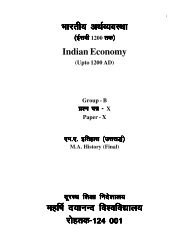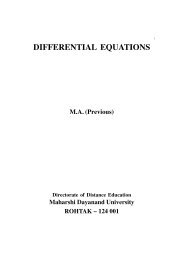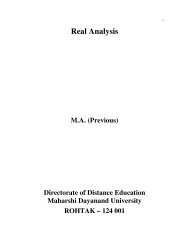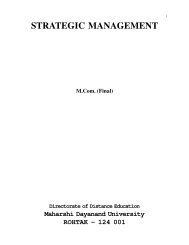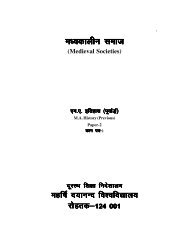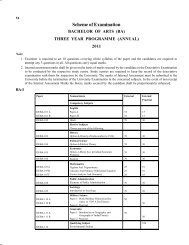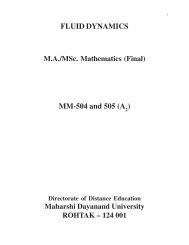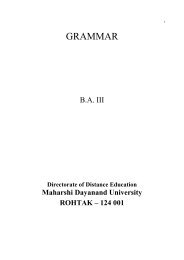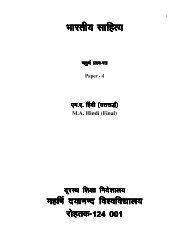LITERATURE AND GENDER - Maharshi Dayanand University, Rohtak
LITERATURE AND GENDER - Maharshi Dayanand University, Rohtak
LITERATURE AND GENDER - Maharshi Dayanand University, Rohtak
Create successful ePaper yourself
Turn your PDF publications into a flip-book with our unique Google optimized e-Paper software.
Girish Karnad – Nagamandal49A young woman is travelling with her insecure and jealous husband and his rather attractive friend. The husband,suspecting his wife’s loyalties, goes to a temple of Goddess Kali and beheads himself The friend finds the body and,terrified that he will be accused of having murdered the man for the sake of his wife, in turn beheads himself. Whenthe woman, afraid of the scandal that is bound to follow, prepares to kill herself too, the goddess takes pity and comes toher aid. The woman has only to rejoin the heads to the bodies and the goddess will bring them back to life. The womanfollows the instructions, the men come back to life except that in her confusion she has mixed up the heads. The storyends with the question: Who is now the real husband., the one with the husband’s head or the one with his body?The answer given in the Kathasaritsagara is: since the head represents the man, the person with the husband’s head is the husband.Mann brings his relentless logic to bear upon this solution. If the head is the determining limb, then the body shouldchange to fit the head. At the end of Mann’s version, the bodies have changed again and adjusted themselves to theheads so perfectly that the men are physically exactly as they were at the beginning. We are back to square one-theproblem remains unsolved.As I said, the story initially interested me for the scope it gave for the use of masks and music. Western theatre hasdeveloped a contrast between the face and the mask-the real inner person and the exterior one presents, or wishes topresent, to the world outside. But in traditional Indian theater, the mask is only the face ‘writ large’; since a characterrepresents not a complex psychological entity but an ethical archetype, the mask merely presents in enlarged detail itsessential moral nature. (This is why characters in Hayavadana have no real names. The heroine is called Padminiafter one of the six types into which Vatsyayana classified all women. Her husband is Devadatta, a formal mode ofaddressing a stranger. His friend is Kapila, simply ‘the dark one.’) Music-usually percussion-then further distancesthe action, placing it in the realm of tile mythical and the elemental.The decision to use masks led me to question the theme itself in greater depth. All theatrical performances in India beginwith worship of Ganesha, the god who ensures successful completion of any endeavour. According to mythology, Ganeshawas beheaded by Shiva, his father, who had failed to recognize his own son (another aggressive father!). The damage vasrepaired by substituting an elephant’s head, since the original head could not be found. Ganesha is often represented onstageby a young boy wearing the elephant mask, who then is worshipped as the incarnation of the god himself’.Ganesha’s mask then says, nothing about his nature. It is a mask, pure and simple. Right at the start of the play, mytheory about masks was getting subverted but the elephant head also questioned the basic assumption behind theoriginal riddle: that the head represents the thinking part of the person, the intellect.It seemed unfair, however, to challenge the thesis of the riddle by using a god. God, after all, is beyond human logic,indeed beyond human comprehension itself. The dialectic had to grow out of grosser ground, and I sensed a thirdbeing hovering in the spaces between the divine and the human, a horse-headed man. The play Hayavadana,meaning ‘the one with a horse’s head,’ is named after this character. The story of this horse-headed man, who wantsto shed the horse’s head and become human, provides the outer panel-as in a mural-within, which the tale of the twofriends is framed. Hayavadana, too, goes to the same Goddess Kali and wins a boon from her that he should becomecomplete: Logic takes over. The head is the person: Hayavadana becomes a complete horse. The central logic of thetale remains intact, while its basic premise is denied.The energy of folk theatre comes from the fact that although it seems to uphold traditional values, it also has themeans of questioning these-values, of making them literally stand on their head.’ The various conventions-the chorus,the masks, the seemingly unrelated comic episodes, the mixing of human and nonhuman worlds-permit the simultaneouspresentation of alternative points of view, of alternative attitudes to the central problem. To use a phrase from BertoltBrecht, these conventions then allow for ‘complex seeing ‘. And it must be admitted that Brecht’s influence receivedmainly through his writings and without the benefit of his theatrical productions, went some way in making us realizewhat could be done with the design of traditional theatre. The theatrical conventions Brecht was reactingagainst--character as a psychological construct providing a focus for emotional identification, thewilling-suspension-of-disbelief syndrome, the notion of a unified spectacle-were never a part of the traditional Indiantheatre. There was therefore no question of arriving at an ‘alienation’ effect by using Brechtian artifice. What he didwas to sensitize us to the potentialities of nonnaturalistic techniques available in our own theatre.



